The Ghost Agent (Part III)
Will the real "Peter van Haperen" please stand up?
Note: if you have not read Part 1 & Part 2 on Peter van Haperen, follow the links.
Two shadowy figures met in a humid café in Paramaribo in June 2011. One was a Belgian police officer handling a routine extradition. The other was a Dutch expatriate who called himself Peter van Haperen—the same man who had recently testified as a star witness in the murder trial of Suriname's former dictator, Desi Bouterse. Their conversation began with casual exchanges, but as trust built between them, the topic turned to Belgium's most notorious unsolved murders—the Brabant Killings. Suddenly, van Haperen's demeanor changed as he revealed something shocking: he had personally trained the killers and knew intimate details of their methods, including specific binding techniques that had never been made public.
This "perpetrator knowledge" led to his formal interrogation on October 13, 2011. Commissioner Eddy Vos recognized that van Haperen possessed insider information that only someone connected to the crimes could know. Yet, puzzlingly, Vos failed to press crucial questions: When and where had van Haperen learned these techniques? Who else participated? What was the purpose of this training?
This strange reluctance to probe deeper wasn't the first oddity in the story of Peter van Haperen. It was merely the latest chapter in the enigma of a man who seemed to exist only in fragments and contradictions—a ghost operating in the shadows of Cold War intelligence networks and post-colonial intrigue. The stakes of unraveling his true story couldn't be higher: if van Haperen's central claim—that the United States government provoked the December Murders that helped solidify Bouterse's power—proved true, it would fundamentally rewrite our understanding of American intervention in Latin America and the Caribbean during the Reagan years and a tragic chapter of Suriname’s history.
The Man Who Wasn't There
The first clue that "Peter van Haperen" might not be who he claimed emerges from the legal record. Court documents from 1982, prior to the December Murders, reveal attempts to locate a "Petrus Adrianus van Haperen" for multiple legal proceedings, including a significant debt to Skol Breweries N.V. amounting to ƒ38,435.17 (approximately €17,440 in today's currency). According to an April 1, 1982 bailiff's notice, he was "without known residence or place of stay in the Kingdom in Europe and elsewhere."
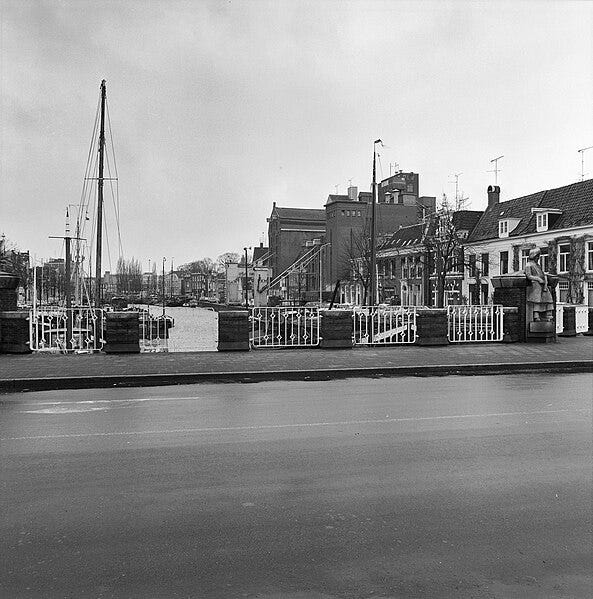
A second legal notice from March 17, 1982 summoned him regarding the sale of his sports school. The document reads:
At the request of Willem Gabriel Bregonje, residing in Groningen... P. A. van Haperen has been summoned, last known to have lived in Groningen at Noorderhaven NZ 39, currently without known residence or stay in the Kingdom in Europe and without known residence or stay elsewhere, to appear on Friday the twenty-sixth of March nineteen hundred eighty-two at 9.00 AM... in order to cooperate in the execution of the purchase agreement regarding the sports school Budo Kwa North-Netherlands at Noorderhaven NZ 39 in Groningen.
At first glance, this legal notice suggests van Haperen owned a sports school that Bregonje was trying to purchase. However, newspaper archives tell a different story—one that reveals a much more complex relationship between the two men and raises questions about van Haperen's actual role in Groningen's martial arts scene.
Newspaper archives from the Nieuwsblad van het Noorden dating back to 1969 contain numerous articles about "Sportschool Wim Bregonje" and "Za-Zen," a karate academy that Bregonje operated. An article from January 1969 states that "The karate club 'Za Zen' is organizing a demonstration of Kyokushinkai karate" where "first dan Wim Bregonje, who teaches at 'Za Zen'" would be featured. Bregonje was known locally for his ice breaking demonstrations, and for teaching self-defense to women and taxi drivers. By September 1969, Za-Zen was described as "the karate club Za Zen of the Wim Bregonje sports school from Groningen." The school produced numerous championship-winning students throughout the early 1970s.
A July 7, 1972 article features an interview with "Mr. P.A. v.d. Bor, director of his sports school in Groningen," described as an expert sports teacher and examiner. While the similar initials "P.A. van der…" might suggest a connection to van Haperen, additional research reveals that P.A. v.d. Bor was active in martial arts in Hilversum during the 1950s—making him too old to be the van Haperen who was described as "34" in 1983 (placing his birth around 1948-1949).
By 1978, advertisements show that "Sportschool Za-Zen," operated by Willem Bregonje, was located at Noorderhaven 39 NZ—the same address where van Haperen would later be documented as residing. This suggests that Za-Zen had been operating at this location for years before the 1982 legal notice involving van Haperen.
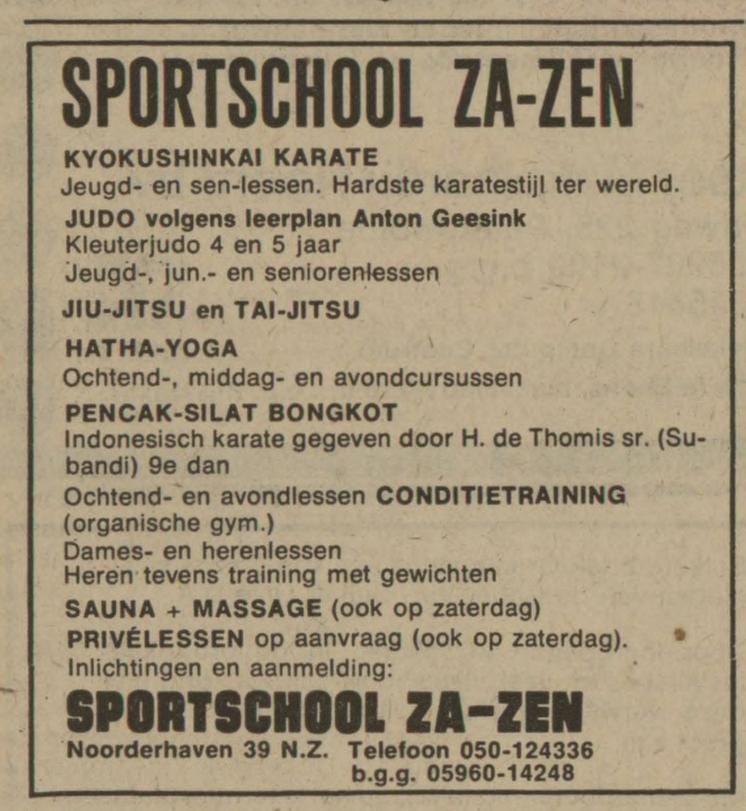
The 1982 legal notices, therefore, paint a different picture: rather than Bregonje attempting to purchase a business from van Haperen, it appears that Bregonje was trying to formalize his full ownership of a property or business in which van Haperen had some financial or legal stake. This suggests a business partnership rather than a straightforward owner-buyer relationship.
Remarkably, a newspaper clipping from November 1984—two years after their legal dispute— supports this, showing van Haperen and Bregonje working together again. The Provinciale Zeeuwse Courant reports that "Peter van Haperen (5th dan) and Wim Bregonje" would be giving martial arts demonstrations together in Goes. This revelation suggests that their relationship survived whatever financial and legal issues prompted the 1982 proceedings.
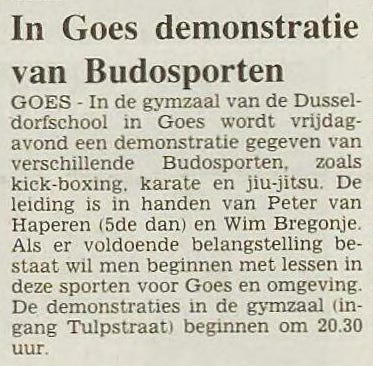
The story takes another turn with a bankruptcy notice from January 15, 1985, declaring the bankruptcy of "Willem Petrus Bregonje, born on 5 November 1932, residing in Amsterdam at Valentijnkade 28-1." Although the original 1982 legal notice referred to "Willem Gabriel Bregonje," a 2007 newspaper article in the Asser Courant refers to "Za-Zen of the late shihan Wim Bregonje at the Noorderhaven in Groningen," confirming that Bregonje was indeed the founder and operator of Za-Zen at that location. Whether "Willem Gabriel" and "Willem Petrus" were the same person with differently recorded middle names, or whether there was a clerical error in one of the legal notices, remains unclear. However, the timeline, geographical connection, and martial arts background strongly suggest they were likely the same individual whose financial problems began with the Noorderhaven property dispute and culminated in bankruptcy two years later.
The Noorderhaven Property and Business Network
The Noorderhaven address itself has a particularly interesting history. Municipal archives reveal that in 1975, a building permit (No. 3399) was issued for "converting the building into a gym." Recent examination shows Noorderhaven NZ 39 to be a multi-use building located in one of Groningen's most picturesque areas—a historic canal district that remains the "last free harbor" in the Netherlands. The red-brick structure features multiple storefronts on the ground floor and several apartments on the upper levels, making it an ideal location for someone needing both a business front and a private residence. The building sits directly across from the canal, where traditional sailing vessels are moored, providing easy water access—a feature that might have appealed to someone involved in clandestine activities.
The multi-use nature of the building raises an interesting possibility: even after losing control of the martial arts studio space in early 1982, van Haperen might have maintained a residential connection to one of the upper-floor apartments. This would explain why he continued to list Noorderhaven 39 as his address on corporate documents for BRAYFORD CONSULTANTS LIMITED in London from 1996-1998, many years after the business dispute.
Van Haperen's reputation as a martial arts instructor appears to have been genuine despite his shadowy activities. The website of a current Za-Zen martial arts school in Groningen contains a biography of its founder, Max Sluiman, who explicitly names Peter van Haperen as one of his most important teachers. Sluiman, born in 1971 in Groningen, writes: "My most important teachers are: Peter van Haperen, an inimitable budoka. And of course my tengu [a mythical Japanese creature often associated with martial arts wisdom]."
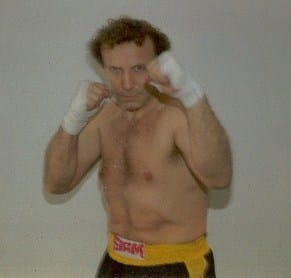
Sluiman not only identifies van Haperen as an important mentor but also recalls him as "a soldier, of course, with firearms. He has had to keep himself alive in battle with his martial art on several occasions." This testimonial from a contemporary martial artist adds an important dimension to van Haperen's background, suggesting his martial arts expertise was not merely a cover identity but a genuine skill set.
According to posts on the "Bende van Nijvel" forum from around January 2012, after van Haperen's disappearance from Noorderhaven 39, the school at that location later became "Kickboxing Noorderhaven," run by Jaap Bruintjes. Today, the building at Noorderhaven 39 houses "Siesta 39," a luxury private spa that advertises itself as providing "relaxation in the heart of Groningen." The address also appears to have housed a cannabis seedshop called "Seedshop" (formerly Prolifiek) at some point.
Even during his alleged absence from the Groningen martial arts scene, van Haperen maintained other connections within the Netherlands. During his testimony regarding the December Murders, he claimed that on December 8, 1982—the date of the killings in Suriname—he was working in a casino, stating: "I led a double life. I was then in a casino, there was no radio or TV." This casino connection gains significance because van Haperen later told Belgian police commissioner Eddy Vos during his 2011 interrogation that he had previously "arranged the security for" an illegal casino in Groningen owned by someone named Jean Berbin. This connection suggests another dimension to his activities—one combining underground criminal networks with his alleged intelligence work. I’ve not been able to locate Berbin.
The Military Mystery: Staphorst and van Haperen (1968-1970)
One of the most persistent claims in Peter van Haperen's narrative was his alleged service in Suriname's TRIS (Troepenmacht in Suriname, the Dutch forces stationed in Suriname) from 1968 to 1969. According to his account, he was initially a first machine gunner with the 4th platoon Bravo company before being transferred to the sports bureau to provide judo instruction as an assistant to Dick Staphorst. Some online commenters even provided what appeared to be a military registration number: 48.07.30.177 (which follows the format and approximate age of a TRIS man of Peter’s age).
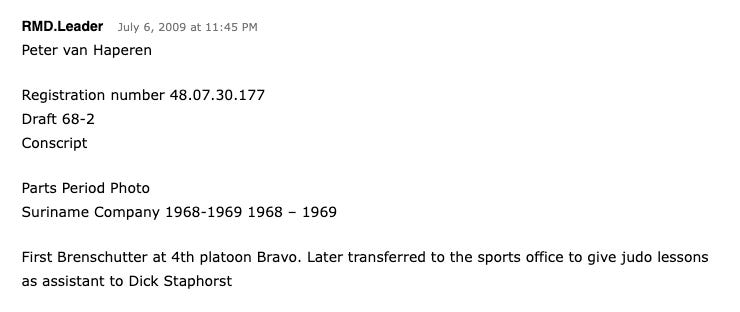
In a more detailed account of his military service, van Haperen claimed: "In 1968-1969, while serving in the Suriname military intelligence unit (TRIS Section 2), I was recruited by my superiors, Major Bavinck and Captain Dicky Mekkering, to map left-wing parties, track extremist signals, and investigate Cuban influence." My own independent research has uncovered a newspaper article from the Nieuwe Leidse Courant, dated March 14, 1964, that mentions "De Engelse instructeur Dick Mekkering" (The English instructor Dick Mekkering) in an aviation context. Verifying Mekkering's existence lends credibility to at least part of van Haperen's account.
However, attempts to verify van Haperen's own military service through direct outreach to TRIS veterans have yielded skeptical responses. Recent correspondence with Jan Oprins, who served with the 2nd platoon A-company (class 70-5) from 1970-1971, revealed that neither 'Peter van Haperen' nor 'Dick Staphorst' were names recognized by the TRIS veterans he contacted.
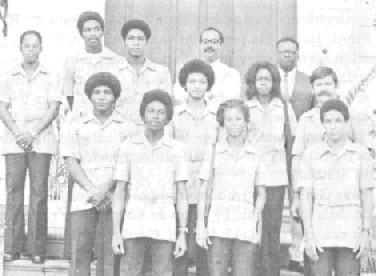
The evidence for Dick Staphorst's existence and role, however, is substantially stronger than for van Haperen. Staphorst is well-documented as having provided sports instruction within TRIS between 1968-1970, with the Surinamese Sports Encyclopedia recording him serving on examination committees alongside other notable figures like Suriname's first judo black belt, and victim of the December Murders, André Kamperveen. Unlike van Haperen, whose military service remains controversial, Staphorst's contributions to Surinamese sports development are extensively documented in official records.
The most intriguing connection comes from an anonymous forum comment suggesting that van Haperen started his TRIS service as "a Bren gunner in 4th Platoon Bravo" before being "transferred to the sports bureau to give judo lessons as an assistant to Dick Staphorst." If accurate, this would place van Haperen in a junior supporting role to Staphorst rather than the intelligence operative he later claimed to be.
This creates what might be called "The Martial Arts Paradox" in van Haperen's narrative: If he truly was Staphorst's judo assistant, why would he completely omit this legitimate role from his later testimony, instead constructing elaborate tales of intelligence work? The discrepancy suggests a deliberate reframing of his military service to appear more significant than it actually was.
The Infiltrator: Resistance and Intelligence
When van Haperen surfaced unexpectedly in Paramaribo in 2009 to testify in Desi Bouterse's trial for the December Murders, he presented an extraordinary account of his involvement in coup attempts against Bouterse's regime. He claimed to have led a counter-coup team on behalf of a covert branch of the Dutch military, with CIA backing and assistance from Carl Armfelt, Oliver North and the NSC.
The 1983 reporting from "Vrij Nederland" described him as "an agent provocateur from the Dutch Counter Intelligence Service (CID)" who had promised Surinamese resistance fighters an invasion with Easter or mid-June to organize a "Westerling coup" in Paramaribo. This timeline aligns perfectly with his documented disappearance from the Za-Zen studio in March 1982, coinciding with the acceleration of coup preparations following the failure of Soerendre Rambocus's attempt.
Dutch intelligence officially denied any knowledge of a 'Captain Van Haperen'. Their spokesperson M. Slingenberg stated: "We have indeed recognized an Intelligence Service, but anyone can present themselves as an agent of that service... When a private individual collects information in the Dutch interest, they get a pat on the back, but no expense reimbursement."
This carefully worded denial—acknowledging that "private individuals" might collect information "in the Dutch interest"—hints at the ambiguous relationship between intelligence services and their unofficial assets. It also explains how van Haperen could possess classified information without appearing in official records.
André Haakmat—a former Surinamese deputy prime minister and key figure in the resistance—initially confirmed that van Haperen had access to detailed military intelligence, including photos of the Dutch detachment for the Middle East and information about the December murders. Documents that, according to Haakmat, "only someone from the intelligence service could have gotten hold of."
However, Haakmat's perspective evolved over time. In a telling twist, a newly uncovered newspaper article from July 1983 (two weeks after van Haperen's disappearance with the resistance funds) reveals that BVD officials personally visited Rudolf Jankie, chairman of the Foundation for Human Rights and Democracy in Suriname, asking if he knew van Haperen. When Jankie replied that he had never heard the name before, the BVD official told him that "the person behind this name is unreliable." This is particularly significant because Jankie was accused months earlier, in October of 1982 , of hiring terrorists and trying to orchestrate a coup before the end of the year—coinciding with the period when van Haperen claims to have been training the Brabant killers and having attended a dinner in Washington with William Casey, Carl Armfelt and others discussing such a coup.

This active intervention by Dutch intelligence in ‘83 to discredit van Haperen suggests either damage control for a rogue asset or the distancing of official agencies from a private operator whose usefulness had ended. Jankie also reported that he believed his phone was being tapped, noting a "ticking" during calls that began after December 1982 - precisely when the resistance activities intensified. Two years later, Janie would require security detail after an assassination attempt was made on the lives of resistance council members.
Mercenary author Rende van de Kamp, who met van Haperen during the coup planning, provides a vivid firsthand account that raises further red flags. Van de Kamp noted that despite claiming to be a Korps Commando Troepen captain, van Haperen's hair was "too long for a commando," he drank whisky early in the morning, and he behaved in an authoritarian manner inconsistent with actual military protocols. Crucially, however, van de Kamp confirmed that van Haperen actually conducted training operations "near Assen and on Texel"—verifying that despite questions about his credentials, he was genuinely organizing paramilitary activities.
The Belgian Connection: Pierre van der Buyten
Yet we are still no closer to knowing who the real Peter— assuming that’s his name— truly is. The variations in names used by Peter suggests a deliberate strategy of identity manipulation:
Peter van Haperen: Used primarily in the Netherlands for business purposes and later when testifying in Suriname
Petrus Adrianus van Haperen: Legal name appearing in court documents spanning from 1982 to 2009
Pierre Adriaen van der Buyten op Ten Tongelberch: Alias used in Belgian circles and claimed by van Haperen himself
"Captain" Petrus Adrianus van Haperen: Title used when organizing the alleged Suriname invasion, though military records show no such captain
In a 2020 article titled "De Beverwijk Files," van Haperen provides a detailed explanation of how he created his Belgian persona:
"Creating a Belgian identity turned out not to be so difficult. My ancestors are mostly from Belgium and specifically from Loenhout near Antwerp. My ancestor Gerard van der Buyten op Ten Tongelberch was also born in 1575 in Loenhout. As a direct descendant and well informed about the family tree, I decided to make my entrance at court and the nobility under the name Pierre Adriaen van der Buyten op Ten Tongelberch."
Intriguingly, historical records from Loenhout do confirm the existence of a Gerard van der Buyten who served as a schoolmaster there in the 17th century. This raises a compelling possibility: If van Haperen's actual family origins were Belgian rather than Dutch, might he have been raised in the Netherlands and served in TRIS under his original family name, explaining why veterans had no recollection of anyone named "van Haperen"?
In online forum posts as "Insider" (later confirmed to be van Haperen), he claimed detailed knowledge of a relatively obscure Belgian military judo champion, Emile Golenvaux:
"Emile was also a military judo champion in the gendarmerie [Dutch/Belgian police force] in the early eighties. We were opponents on the mat, but sports friends outside of it. He knew me as Pierre van der Buyten, I am speaking with him."
This establishes that in Belgian circles, Peter was known not as van Haperen but as Pierre van der Buyten. His detailed description of how he built this identity—complete with forged documents from Interdoc, a luxury apartment in De Haan near Knokke, and a 1968 Jaguar MKII—suggests a level of preparation beyond simple fraud. He claims the identity construction was supervised by CIA agent, Carl Armfelt, who facilitated his introduction to Belgian aristocratic and court circles. This also serves as Peter’s excuse for appearing to have conned the elderly later in life.
The Belgian connection becomes even more significant through van Haperen's alleged link to Madani Bouhouche and the notorious terrorists, the Gang of Nijvel (Brabant Killers). In his 2011 Belgian police interrogation, van Haperen demonstrated detailed knowledge of binding techniques used in these murders—techniques never made public. His explanation was that he had taught these methods during coup training in 1982, creating a disturbing link between the Surinamese coup attempts and one of Europe's most infamous unsolved crime sprees. This also aligns with the claims by Surinamese intelligence mentioned earlier.
Patterns of Disappearance and Financial Motives (1982-2025)
Throughout his decades-long history, van Haperen has been characterized by strategic appearances and disappearances that align with significant political events or financial opportunities:
1982-1984: Disappears from the Netherlands at the height of alleged coup preparations with significant debt, resurfaces in Surinamese resistance circles after the December Murders, then vanishes again with 300,000 guilders from the resistance funds only to re-appear briefly after Reagan’s ‘83 coup is called off in 1984 teaching martial arts.
1984-2003: A twenty-year gap in his documented activities, though legal notices seeking him continue to appear. His whereabouts during this period remain largely unknown.
2003-2005: Resurfaces in Spain, where he is later exposed on the Dutch television program "Tros Opgelicht?!" for allegedly defrauding Dutch retirees while posing as a lawyer and financial advisor.
2009-2012: Makes his dramatic reappearance in Paramaribo to testify in the Bouterse trial, offering controversial testimony that supports Bouterse's narrative about the December murders.
2013-2018: Engages in writing books about his experiences, repeatedly announcing publication dates that are continually delayed. His book "The Secret Life of the Count" about Carl Armfelt and "Interdoc: The Spy Years 1972-1985" remain perpetually forthcoming.
2025: Possible reemergence through email communications with Dutch investigative blogger Wim Dankbaar, using similar operational patterns to those established decades earlier.
A compelling financial pattern emerges when examining van Haperen's activities chronologically. The timing between his documented financial troubles in early 1982 (debts to Skol Breweries) and his subsequent acquisition of substantial funds from the resistance suggests at least a partial financial motivation for his activities.
Given that Za-Zen/Budo Kwa appears to have been more than just a training facility—offering amenities like sauna and massage—it likely included a social area with a bar. The substantial debt to Skol suggests a significant business relationship, possibly involving financing for building renovations or sponsorship arrangements.
If van Haperen was using the martial arts school primarily as an intelligence cover, the Skol debt might represent operational expenses rather than personal financial mismanagement. Alternatively, if he was genuinely struggling financially, the opportunity to acquire funds from the Surinamese resistance may have presented an irresistible solution to mounting debts.
The Ghost's Latest Appearance: 2025 Claims
The story of Peter van Haperen doesn't end with his 2009 testimony in Suriname or the 2011 Belgian police interrogation. In what may be his most recent manifestation, a series of blog posts from February-April 2025 claim to document extensive email exchanges between someone using the address "pvanhap@hotmail.com" and a Dutch investigative blogger named Wim Dankbaar, who runs a website focused on alleged government conspiracies and cover-ups.
If these communications are indeed from the original Peter van Haperen, they would come from a man in his mid-to-late 70s. Based on contemporaneous reports, van Haperen was described as "34" years old in 1983 by the Dutch weekly "Vrij Nederland," which would place his birth year around 1948-1949, making him approximately 77 years old in 2025.
These unverified communications show striking similarities to the operational patterns established by the historical Peter van Haperen:
Intelligence claims: The emails claim connections to Dutch intelligence, specifically working "under the direction of the Dutch Ministry of Justice and Security" as a "team leader" for Secretary General Anneke van Dijk.
Document procurement: The communications revolve around obtaining mysterious papers (referred to as "Fayek's papers") that allegedly contain damaging information about Dutch government officials.
Financial schemes: Throughout the exchanges, there are demands for specific amounts of money (400 euros, 1200 euros, 2000 euros) for various services or information.
Strategic delays: The emails document a pattern of setting up meetings and then not appearing, repeatedly rescheduling with excuses about surveillance or official interference.
Dual-role operations: The writer positions himself as both working for Dutch officials and potentially willing to betray them for the right price.
This approach mirrors the historical van Haperen's method of positioning himself between competing interests to extract maximum benefit while maintaining plausible deniability. Whether these 2025 communications genuinely involve the same Peter van Haperen who testified in Suriname in 2009 is impossible to verify, but the operational consistency across decades is remarkable.
The Ghost Identity: Conclusions and Questions
After examining all available evidence, several conclusions emerge about the enigmatic figure known as "Peter van Haperen":
Verifiable Identity: Despite official denials, there is documentary evidence of Peter van Haperen's physical existence in Groningen during the late 1970s, early 1980s, and possibly as late as the 1990’s with a legitimate connection to the martial arts community.
Financial Pattern: His activities consistently align with financial need or opportunity, suggesting this may have been a primary motivator regardless of any potential intelligence connections.
Martial Arts Expertise: His judo training was not merely cover but a genuine skill set that facilitated his operations, providing legitimate access to networks and physical training capabilities.
Intelligence Connections: Despite official denials, he demonstrated verifiable knowledge of classified operations and access to restricted information that strongly suggests intelligence connections, even if only as a freelance asset rather than an official operative.
Strategic Disappearances: His pattern of vanishing precisely when legal consequences loomed suggests a calculated approach to identity management rather than random flight.
Active BVD Intervention: The Dutch intelligence service's active discrediting of van Haperen after his disappearance with resistance funds suggests either damage control for a rogue asset or deliberate distancing from a private operator whose usefulness had ended.
Perhaps most remarkably, despite decades of questions about his identity and credibility, Peter van Haperen's testimony was deemed admissible in Desi Bouterse's trial for the December Murders. The testimony was so significant that it led to a suspension of the trial so that van Haperen could be properly heard. His statements about a planned Christmas Eve coup in 1982 were repeatedly cited by Bouterse's defense attorney as evidence that Bouterse's actions were preemptive measures against Western-backed plotters.
Yet crucial questions remain unanswered:
Was van Haperen operating as part of a larger coordinated effort involving American intelligence or military interests in the Caribbean Basin?
Could his Belgian connection—including the alleged training of operatives later linked to the Brabant Killings—indicate involvement in a broader NATO-aligned paramilitary network similar to Operation Gladio?
If van Haperen was indeed training paramilitaries for a Christmas coup, who authorized and coordinated these activities? Were they sanctioned by traditional intelligence services or by parallel structures within Western governments?
Was the planned December 1982 “Red Christmas” coup that Bouterse preemptively disrupted with the December Murders a real operation, and if so, what agencies or governments were behind it?
How much of van Haperen's testimony about covert operations was genuine insider knowledge versus clever reconstruction from available intelligence and news?
These questions may never be fully resolved, but emerging evidence suggests van Haperen may have operated more as a temporary, early 80s 'cutout'—an intermediary used to shield organizers from direct involvement—similar to figures like Gary Larson, Frank Castro, and John Hull—agents used by figures like Oliver North to maintain plausible deniability for sensitive operations. His placement at the intersection of Dutch, Belgian, and American interests during the early Reagan administration places him precisely where key decisions were being made about confronting Soviet-Cuban influence in the Caribbean.
In next week's article, we'll explore recently declassified documents that shed new light on U.S. involvement in Suriname during this critical period, including revelations about Project Democracy operations that align startlingly well with van Haperen's most explosive claims about a planned Christmas coup in 1982.
The enigma of Peter van Haperen offers a rare glimpse into the shadowy world where intelligence operations, opportunistic fraud, and political manipulation intersect. In the murky world of covert operations, sometimes the most valuable assets are those who don't officially exist. And few have mastered the art of non-existence quite like the man who called himself Peter van Haperen.



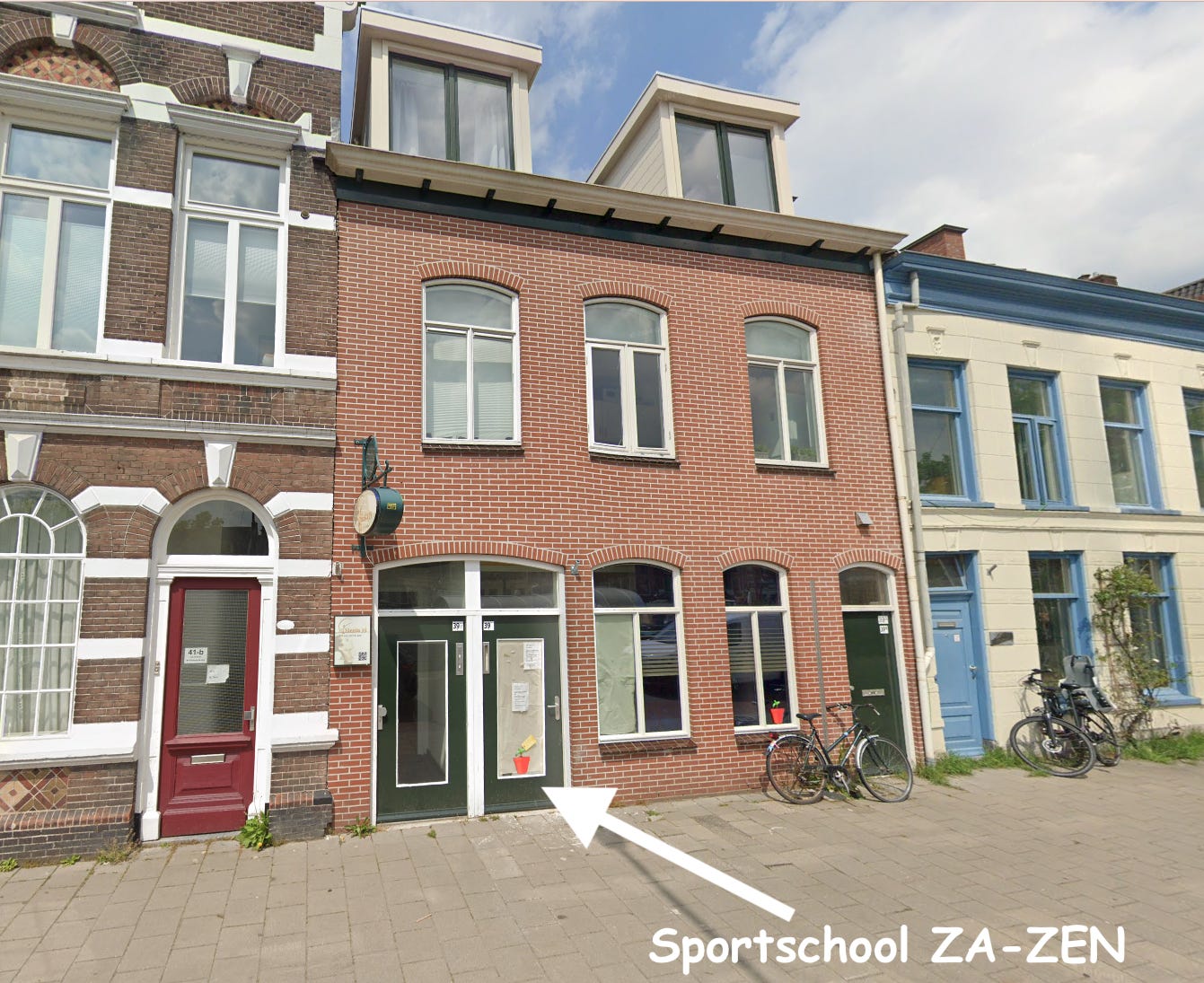

Super interesting stuff. To keep track of all of this, do you have an entire room in your house dedicated to photos, documents, and string to tie it all together? :)